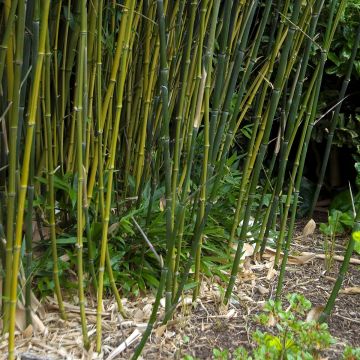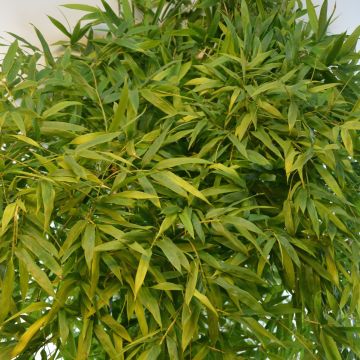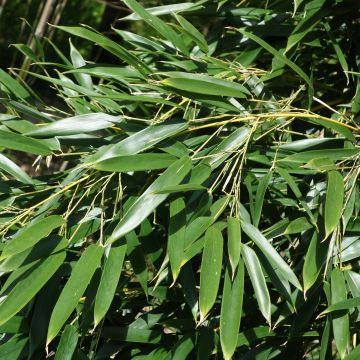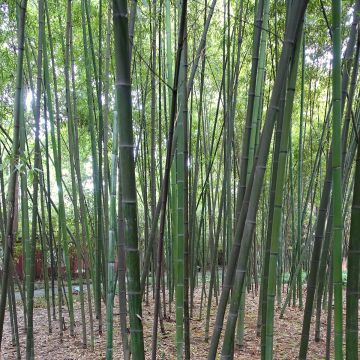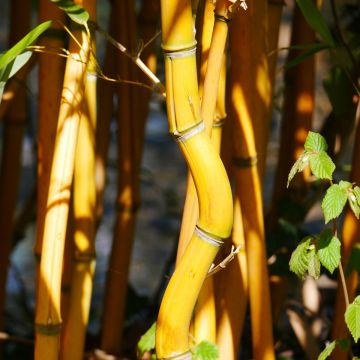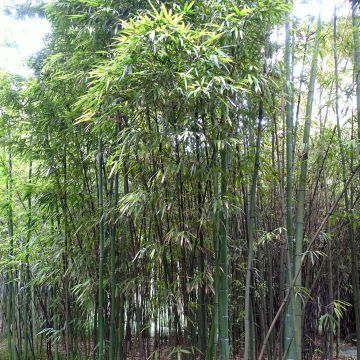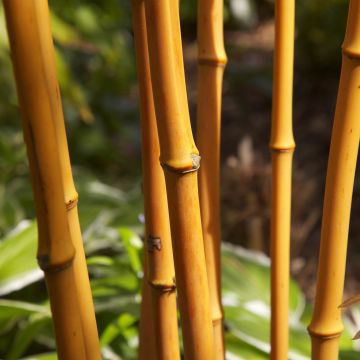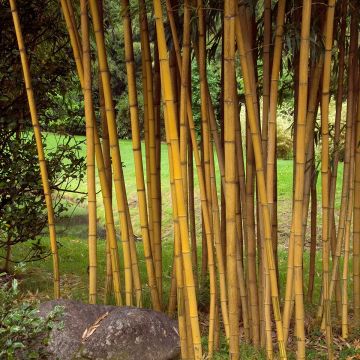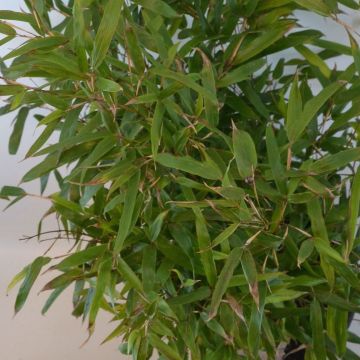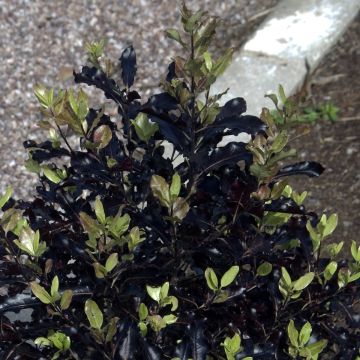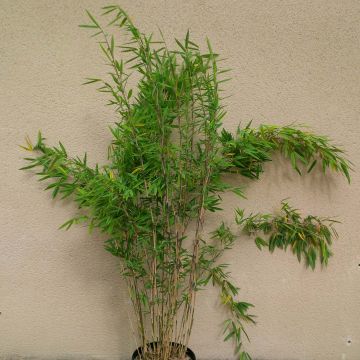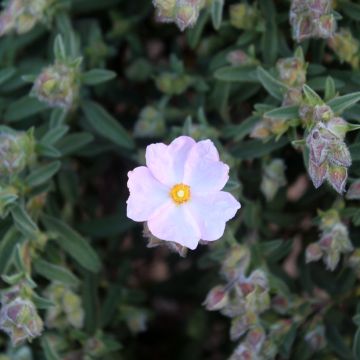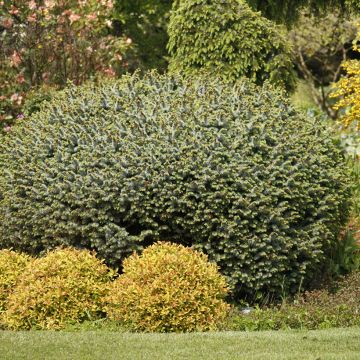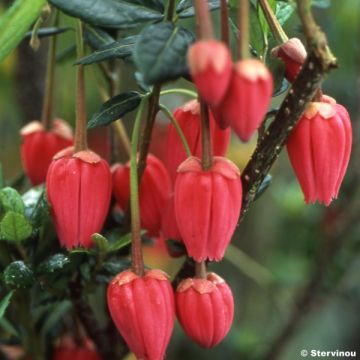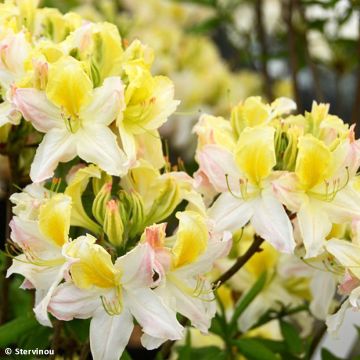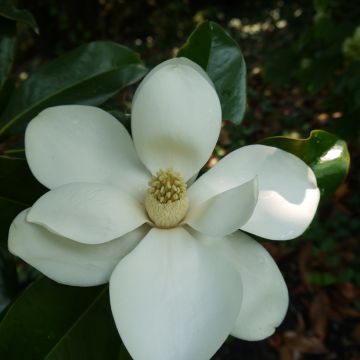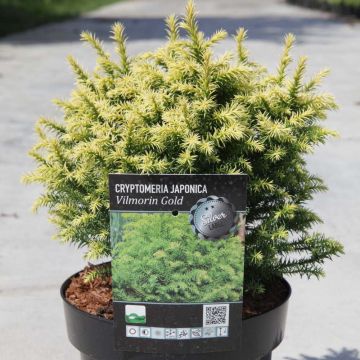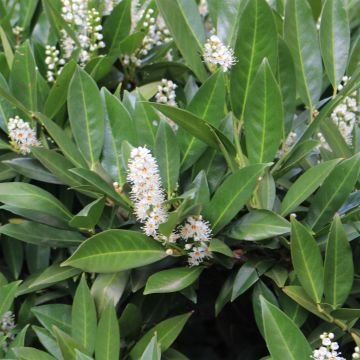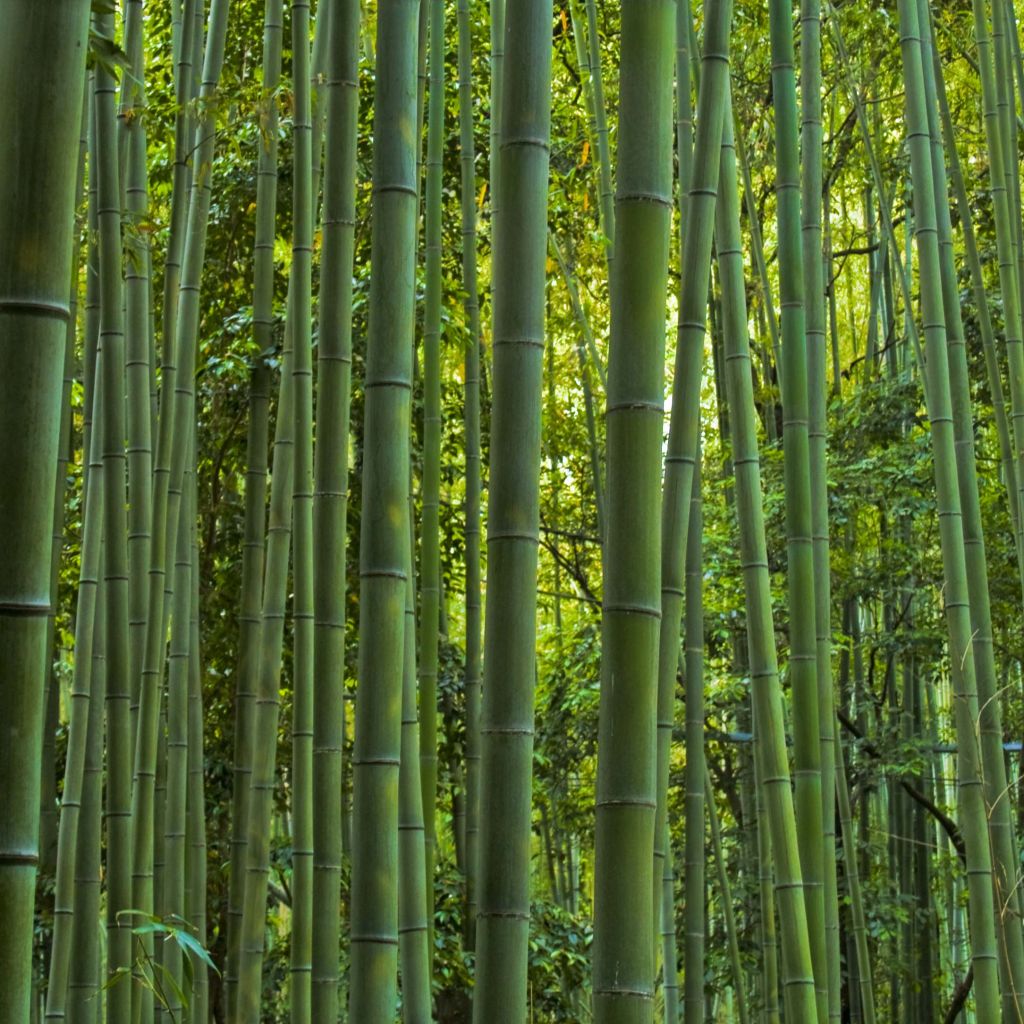

Phyllostachys vivax MacClure (type) - Bambou géant
Phyllostachys vivax MacClure - Golden Chinese Timber Bamboo
Phyllostachys vivax MacClure
Golden Chinese Timber Bamboo
Fast. Very well packaged. Some leaves a bit dry upon arrival, but it's bamboo, so it seems rather Normal to me. Also glad to see that there is a delivery verification stamp, in case of any issues it could be very useful.
Siegfried V., 15/05/2018
This item cannot be shipped to the selected country
Oversize package delivery charge from €6.90
Oversize package delivery charge from €6.90
More information
Schedule delivery date,
and select date in basket
This plant carries a 24 months recovery warranty
More information
We guarantee the quality of our plants for a full growing cycle, and will replace at our expense any plant that fails to recover under normal climatic and planting conditions.
Oversize package: home delivery by special carrier from €6.90 per order..
Express home delivery from €8.90.
Oversize package: home delivery by special carrier from €6.90 per order..
Express home delivery from €8.90.

Does this plant fit my garden?
Set up your Plantfit profile →
Description
Phyllostachys vivax 'MacClure' is a giant bamboo that is rarely found in cultivation where it is often confused with other clones. This one, recognizable by its almost black young shoots, appears to be the most cold-resistant. With remarkable vigour, it develops culms as wide as poles adorned with a beautiful emerald green colour highlighted by white rings, and lush, flexible, and well-furnished evergreen foliage. This trailing variety allows for the rapid establishment of a remarkable bamboo forest or hedge. This wonderful bamboo thrives in moist soil, in the sun, in a sheltered location away from strong winds because its thin-walled culms are brittle.
Native to eastern China, in the Henan and Zhejiang provinces, as well as Japan, Phyllostachys vivax is a vigorous bamboo with a highly rapid growth even in cold climates. It belongs to the family of Poaceae (or grasses), it is a kind of giant grass with woody stems.
The 'MacClure' cultivar was introduced to Europe in 1981. It is endemic to Chinese provinces, specifically the south of Zhejiang, Jiangxi, Henan, Hunan, Jiangsu, Shandong, and the south of Yunnan province. Its hardiness is estimated at -18/-20°C for a short period.
This bamboo shows an initially arched and then upright habit over time, and its canes bear beautifully trailing leafy branches. The stump produces numerous shoots covered with a strongly marbled black sheath. These shoots release culms or canes with a diameter of 6 to 8cm (2 to 3in), with a relatively thin and not very resistant wall to strong winds and the weight of vegetation when laden with snow. They are capable of growing several centimetres per day to reach a height of 7, 12 or even 15m. Each culm is slightly channelled, emerald green in colour, marked by white bloom rings just below the nodes. Older culms take on a grey, rusty, or yellow-green colouration. The evergreen foliage is composed of beautiful, pendant lanceolate leaves, tapering at their tips, 16cm (6in) long and 1.5cm (1in) wide. Their colour evolves from bluish-green to bright and vibrant green, slightly glossy. In case of snowfall, remember to clear the culms by shaking them, as the weight could cause them to bend and break at ground level.
A true star of Asian-inspired gardens, giant bamboo suits many styles, from contemporary to exotic, including natural gardens or water gardens. Planted en masse, it allows for the rapid creation of very exotic forests, and its graphic design brings verticality to the decor. Its fast growth makes it an excellent candidate for concealing an unsightly view, especially when planted in fertile and moist soil. It is so striking that you can plant it as a solitary clump. However, its unique style can sometimes be difficult to blend in a mass planting. For example, try combining it in an exotic setting with Gunnera manicata or Hosta 'Big Daddy', or certain palms in a more well-drained soil. Bamboos complement each other very well, so choose varieties with differently coloured culms. They are always perfect near water features as they seek coolness. A large avenue lined on both sides with 'MacClure' giant bamboos will simply become a royal avenue.
The young shoots of this bamboo are edible and highly prized by gastronomes. However, it is necessary to boil them for a long time to remove bitterness before consuming.
Report an error about the product description
Phyllostachys vivax MacClure - Golden Chinese Timber Bamboo in pictures
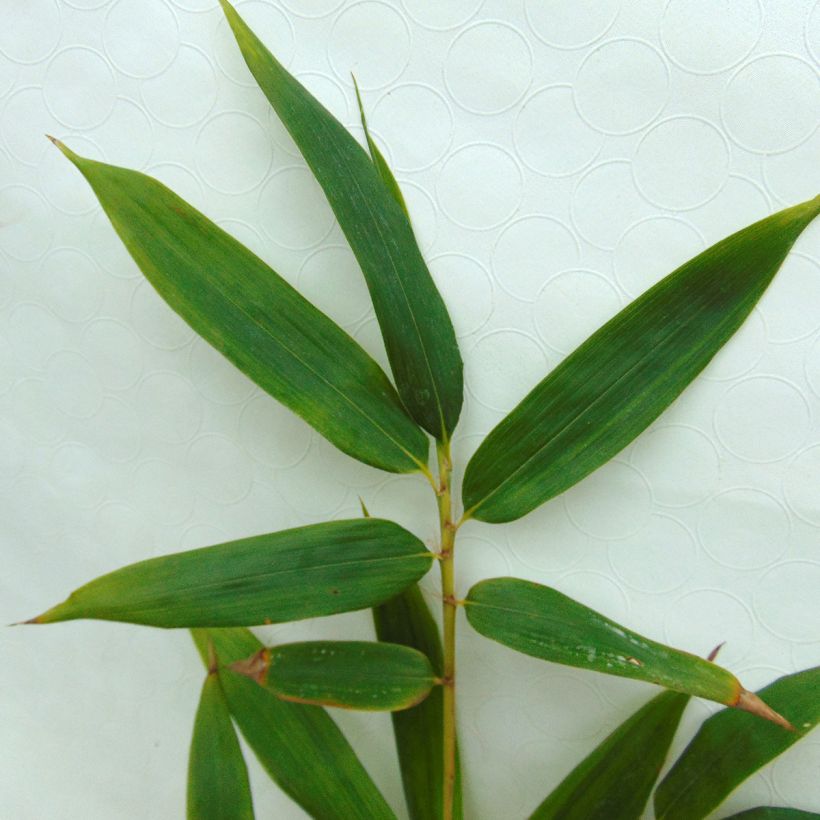

Plant habit
Foliage
Botanical data
Phyllostachys
vivax
MacClure
Poaceae
Golden Chinese Timber Bamboo
China
Other Phyllostachys
Planting and care
Grown in containers, bamboo can be planted at any time of the year, except during frost. Nevertheless, the best planting period is late summer and autumn, when the soil is warm and rainfall is more frequent. The planting distance depends on how you will use your bamboo: for a mass planting, allow a gap of 3 to 4 metres (10 to 13 feet) between each plant. For a hedge, this distance is reduced to 1.6 to 2 metres (5 to 7 feet).
In general, bamboo prefers rich, deep, well-drained soil that remains moist, acidic, or neutral. They can tolerate slightly calcareous soil, depending on the variety. Phyllostachys vivax 'MacClure' appreciates the sun but tolerates partial shade.
During planting, do not hesitate to loosen the soil and moisten the root ball well by soaking it. You can add well-decomposed compost that you will scratch into the surface. Watering should be followed for at least the first year in open ground and continuously if your bamboo is grown in a pot. The establishment period may sometimes seem a little long, but don't panic!
For running bamboo, the installation of a rhizome barrier (thick and resistant polypropylene film) is essential because these varieties, which do not care about property boundaries, can quickly colonize large areas. The rhizome barrier should be buried vertically, leaving a height of 10cm (4in) exposed, which should be tilted 15° towards the plant.
As for maintenance, bamboo is not demanding: remember to weed around the base at least in the beginning until the dead leaves on the ground form a natural mulch. An application of nitrogen fertilizer (well-decomposed manure or liquid fertilizer) in spring and autumn can be beneficial. Water regularly during bamboo establishment, especially during abnormally dry weather. Bamboo may take some time to establish, but in the long run, they prove to be true forces of nature that will be difficult to remove.
Planting period
Intended location
Care
-
, onOrder confirmed
Reply from on Promesse de fleurs
Evergreen shrubs
Haven't found what you were looking for?
Hardiness is the lowest winter temperature a plant can endure without suffering serious damage or even dying. However, hardiness is affected by location (a sheltered area, such as a patio), protection (winter cover) and soil type (hardiness is improved by well-drained soil).

Photo Sharing Terms & Conditions
In order to encourage gardeners to interact and share their experiences, Promesse de fleurs offers various media enabling content to be uploaded onto its Site - in particular via the ‘Photo sharing’ module.
The User agrees to refrain from:
- Posting any content that is illegal, prejudicial, insulting, racist, inciteful to hatred, revisionist, contrary to public decency, that infringes on privacy or on the privacy rights of third parties, in particular the publicity rights of persons and goods, intellectual property rights, or the right to privacy.
- Submitting content on behalf of a third party;
- Impersonate the identity of a third party and/or publish any personal information about a third party;
In general, the User undertakes to refrain from any unethical behaviour.
All Content (in particular text, comments, files, images, photos, videos, creative works, etc.), which may be subject to property or intellectual property rights, image or other private rights, shall remain the property of the User, subject to the limited rights granted by the terms of the licence granted by Promesse de fleurs as stated below. Users are at liberty to publish or not to publish such Content on the Site, notably via the ‘Photo Sharing’ facility, and accept that this Content shall be made public and freely accessible, notably on the Internet.
Users further acknowledge, undertake to have ,and guarantee that they hold all necessary rights and permissions to publish such material on the Site, in particular with regard to the legislation in force pertaining to any privacy, property, intellectual property, image, or contractual rights, or rights of any other nature. By publishing such Content on the Site, Users acknowledge accepting full liability as publishers of the Content within the meaning of the law, and grant Promesse de fleurs, free of charge, an inclusive, worldwide licence for the said Content for the entire duration of its publication, including all reproduction, representation, up/downloading, displaying, performing, transmission, and storage rights.
Users also grant permission for their name to be linked to the Content and accept that this link may not always be made available.
By engaging in posting material, Users consent to their Content becoming automatically accessible on the Internet, in particular on other sites and/or blogs and/or web pages of the Promesse de fleurs site, including in particular social pages and the Promesse de fleurs catalogue.
Users may secure the removal of entrusted content free of charge by issuing a simple request via our contact form.
The flowering period indicated on our website applies to countries and regions located in USDA zone 8 (France, the United Kingdom, Ireland, the Netherlands, etc.)
It will vary according to where you live:
- In zones 9 to 10 (Italy, Spain, Greece, etc.), flowering will occur about 2 to 4 weeks earlier.
- In zones 6 to 7 (Germany, Poland, Slovenia, and lower mountainous regions), flowering will be delayed by 2 to 3 weeks.
- In zone 5 (Central Europe, Scandinavia), blooming will be delayed by 3 to 5 weeks.
In temperate climates, pruning of spring-flowering shrubs (forsythia, spireas, etc.) should be done just after flowering.
Pruning of summer-flowering shrubs (Indian Lilac, Perovskia, etc.) can be done in winter or spring.
In cold regions as well as with frost-sensitive plants, avoid pruning too early when severe frosts may still occur.
The planting period indicated on our website applies to countries and regions located in USDA zone 8 (France, United Kingdom, Ireland, Netherlands).
It will vary according to where you live:
- In Mediterranean zones (Marseille, Madrid, Milan, etc.), autumn and winter are the best planting periods.
- In continental zones (Strasbourg, Munich, Vienna, etc.), delay planting by 2 to 3 weeks in spring and bring it forward by 2 to 4 weeks in autumn.
- In mountainous regions (the Alps, Pyrenees, Carpathians, etc.), it is best to plant in late spring (May-June) or late summer (August-September).
The harvesting period indicated on our website applies to countries and regions in USDA zone 8 (France, England, Ireland, the Netherlands).
In colder areas (Scandinavia, Poland, Austria...) fruit and vegetable harvests are likely to be delayed by 3-4 weeks.
In warmer areas (Italy, Spain, Greece, etc.), harvesting will probably take place earlier, depending on weather conditions.
The sowing periods indicated on our website apply to countries and regions within USDA Zone 8 (France, UK, Ireland, Netherlands).
In colder areas (Scandinavia, Poland, Austria...), delay any outdoor sowing by 3-4 weeks, or sow under glass.
In warmer climes (Italy, Spain, Greece, etc.), bring outdoor sowing forward by a few weeks.

































